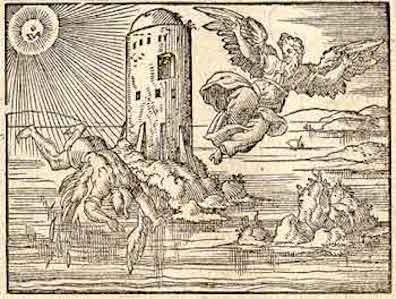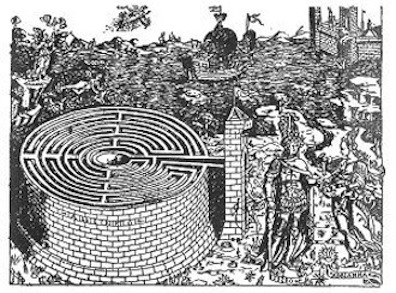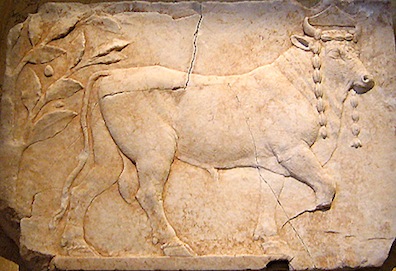Daidalos (Latin Daedalus) means “cunning workman,” “fine
craftsman,” or “fabulous artificer” (this
last phrase comes from A Portrait of the
Artist, and Joyce repeats it Scylla and Charybdis). Stephanos
means crown or wreath, and carries associations with the
garlands that were draped over the necks of bulls marked for
sacrifice. The first Christian martyr was named St. Stephen,
probably because of this association with sacrifice.
Dedalus was a legendary artisan whose exploits were narrated
by ancient poets from Homer to Ovid. A Portrait opens
with an epigraph from Ovid’s Metamorphoses: et
ignotas animum dimittit in artes, “and he applies his
mind to unknown arts." It concludes with a secular prayer:
“Old father, old artificer, stand me now and ever in good
stead.” Both are references to Daedalus. Between these
bookends, the autobiographical
persona who has inherited the craftsman’s name discovers
his vocation as a literary artist and begins to prepare
himself for writing a great work of Irish art. He hopes one
day “to forge in the smithy of my soul the uncreated
conscience of my race.” The Portrait, then,
presents Stephen as potentially an artificer
comparable to the legendary Greek craftsman, his spiritual father. Whether he
will actually become such an artist is a question that Ulysses
raises but does not definitively answer. It is a possibility
that has not yet become actual.
Daedalus was famed for three particular creations, one of
which comments upon Stephen’s son-like combination of
potential and immaturity. Ovid tells the story of how the
craftsman, trapped on Crete by King Minos, fashioned two pairs
of artificial wings to escape his island prison—one for
himself and one for his son Icarus. He warned Icarus not to
fly too high, lest the heat of the sun melt the wax attaching
the feathers to the artificial wings. Carried away with the
joy of flight, Icarus forgot his father’s warning, flew too
close to the sun, and fell to his death in the sea. If Stephen
is more like the son than the father, then his efforts to fly
will be marked by disastrous failure more than triumph.
Both A Portrait and Ulysses confirm this
expectation. The earlier novel establishes a recurring pattern
of triumph followed by failure, flight followed by descent. It
ends on a high note, with Stephen resolving to “fly by” the
nets thrown at the soul in Ireland “to hold it back from
flight.” He looks at birds in flight and thinks “of the
hawklike man whose name he bore soaring out of captivity on
osierwoven wings.” He prepares to go “Away! Away!” (to Paris), thinking of
kindred souls “shaking the wings of their exultant and
terrible youth.” But Ulysses finds him back in
Dublin, picking seaweed off his broken wings. He is
unachieved and unrecognized as an artist, unloved and unwed in a book
whose subject is sexual love, and soon to be unhoused
and unemployed.
In Proteus Stephen imagines his father Simon
learning that he has been hanging out in the run-down house of his Aunt
Sally and responding with contemptuous derision: "Couldn't
he fly a bit higher than that, eh?" In Scylla
and Charybdis he thinks, “Fabulous artificer.
The hawklike man. You flew. Whereto? Newhaven-Dieppe,
steerage passenger. Paris and back. Lapwing. Icarus. Pater,
ait. Seabedabbled, fallen, weltering. Lapwing you
are. Lapwing be.” The cry of Pater
(“Father”) identifies him with Daedalus’ much-loved son.
“Lapwing” identifies him with a low-flying, non-soaring bird
that also figures in the mythology of Daedalus. In Ovid
Renewed: Ovidian Influences on Literature and Art from the
Middle Ages to the twentieth century, edited by Charles
Martindale (Cambridge UP, 1988), Niall Rudd notes that "in
spring the bird gives an odd aerobatic display, climbing
upwards and then plunging down, rolling and twisting,
apparently out of control" (50). "Seabedabbled" apparently
echoes a word in Shakespeare's Venus and Adonis,
"dewbedabbled." Gifford cites a short article in JJQ
19.2 (1982): 176 in which Erlene Stetson notes that line 703
of the poem uses that coinage to describe a hare exhausted by
running from the hounds.
The myth of Dedalus and Icarus, then, becomes one more
ancient Greek template in Ulysses for Stephen’s
halting growth into manhood, paralleling the stories of Hamlet and Telemachus.
As in those stories, there are as many grounds for hope as for
despair. In Scylla and Charybdis, Stephen recalls a
dream he had the night before: “Last night I flew.
Easily flew. Men wondered.” Circe
literalizes this hopeful fantasy, having Stephen assert, “No,
I flew. My foes beneath me. . . . Pater! Free!”
while Simon Dedalus, playing the artistic father, “swoops
uncertainly through the air, wheeling, uttering cries of
heartening, on strong ponderous buzzard wings.”
Daedalus’ second famous creation (moving backward rather than
forward through his life) was the Labyrinth that he
constructed beneath the palace of Knossos to house the
half-man half-bull Minotaur. (Scholars speculate that the myth
of the Labyrinth may have been inspired by the elaborate floor
plan of the actual palace, whose size and complexity were
extraordinary.) If any work of twentieth century fiction, or
indeed of world literature in any age, can be compared to a
labyrinth, it is Ulysses—with the difference that,
whereas Theseus had one thread to retrace his steps through
the dangerous maze, Joyce’s reader encounters countless
connections between widely separated parts of the book. Joyce
seldom employed the image of the labyrinth, however. (In the
Linati schema, it appears as the "technique" of Wandering
Rocks.)
Daedalus’ first work involved cattle, in what Oxen of
the Sun calls the fable "of the Minotaur which
the genius of the elegant Latin poet has handed down to us
in the pages of his Metamorphoses." The artificer
helped Pasiphae, the queen of Crete, to satisfy her desire for
a particularly good-looking bull by constructing a hollow
artificial cow that allowed the bull’s penis to enter both it
and her. The fruit of this copulation was the Minotaur. Bulls
were central to Minoan civilization; it worshiped them, and
young men and women performed a spectacular ritual of vaulting
over them by gripping their horns. Minos himself sprang from
the union of Europa with the white bull in which Zeus visited
her, and Poseidon inflicted Pasiphae’s lust upon her as
punishment for Minos’ refusal to sacrifice a particularly
magnificent sea-born bull to the god.
Joyce alludes to the racy story of Pasiphae in Scylla
and Charybdis, when Stephen’s list of sexual taboos
includes “queens with prize bulls,” and in Circe,
when he thinks again of the woman “for whose lust my
grandoldgrossfather made the first confessionbox.”
He may also be alluding to it obliquely in Oxen of the
Sun, when bulls and sex again get mixed up with
religion and confession: “maid, wife, abbess, and widow to
this day affirm that they would rather any time of the month whisper
in his ear in the dark of a cowhouse or get a lick
on the nape from his long holy tongue than lie with the finest
strapping young ravisher in the four fields of all Ireland . .
. and as soon as his belly was full he would rear up on his
hind quarters to show their ladyships a mystery and roar and
bellow out of him in bulls’ language and they all after
him.”
These particular passages may only characterize Stephen by
contrast (as someone who rejected
the priesthood), but he is repeatedly associated with
cattle in general and bulls in particular, beginning with the
first sentence of A Portrait of the Artist: “Once
upon a time and a very good time it was there was a moocow
coming down along the road and this moocow that was coming
down along the road met a nicens little boy named baby
tuckoo.” Later in Portrait the cries of some swimming
boys—“Come along, Dedalus! Bous Stephanoumenos! Bous
Stephaneforos! . . . Stephanos Dedalos! Bous Stephanoumenos!
Bous Stephaneforos!”—make him briefly a Greek bull, ox, or cow
(Bous is gender-indeterminate). His agreement in Nestor
to carry Mr Deasy’s letter to two newspaper editors makes him
think, “Mulligan will dub me a new name: the
bullockbefriending bard”—a phrase which floats
through his mind in two later episodes. In Oxen, the
two motifs come together: “I, Bous Stephanoumenos,
bullockbefriending bard, am lord and giver of their life. He
encircled his gadding hair with a coronal of vineleaves,
smiling at Vincent. That answer and those leaves, Vincent
said to him, will adorn you more fitly when something more,
and greatly more than a capful of light odes can call your
genius father.”
As Stuart Curran has observed in "'Bous Stephanoumenos':
Joyce's Sacred Cow," JJQ 6:2 (Winter 1969): 163-70,
Stephen's friends in Portrait seem to be ridiculing
him as "something of a blockhead who refuses to join their
fun," but the verb stephanon means "to encircle or
wreathe," and the noun stephanos means "wreath or
crown," so his very name identifies Stephen as "a hero, a youth singled out from the
mass of his countrymen" (163). He and Vincent play upon the
notion that great poets are crowned with laurel wreaths—with
Vincent observing that he has not yet deserved such accolades,
having written only a handful of short lyrics. But the root
sense of his name also identifies him as a sacrificial victim, since the
garlanded oxen of ancient Greece were marked for slaughter,
and (as Curran also observes) the Greek passive verb stephanomai
can mean “to be prepared for sacrifice” (167). Thus the
“ancient Greek” significance of stephanos forms an
intelligible link to the other figure who is usually regarded
as a basis of the name Joyce chose for his autobiographical
persona: St. Stephen Protomartyr, the first of the Christian
martyrs.






